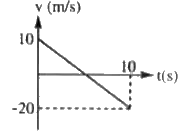A locomotive of mass 'm' starts moving so that its velocity varies as V=K√S , where 'K' is a constant and 'S', is the distance traversed. The total work done by all the forces acting on the locomotive during the first 't' seconds after the start of motion is,Solution in Telugu
12mK4t2
14mK4t2
18mK4t2
116mK4t2
The correct Answer is:C
Step by step video, text & image solution for A locomotive of mass 'm' starts moving so that its velocity varies as V = Ksqrt(S) , where 'K' is a constant and 'S', is the distance traversed. The total work done by all the forces acting on the locomotive during the first 't' seconds after the start of motion is, by Physics experts to help you in doubts & scoring excellent marks in Class 11 exams.
Topper's Solved these Questions
- BOOK - AAKASH SERIESCHAPTER - WORK, POWER & ENERGY EXERCISE - EXERCISE - II (ENERGY)33videos
WORK, POWER & ENERGY
- BOOK - AAKASH SERIESCHAPTER - WORK, POWER & ENERGY EXERCISE - EXERCISE - II (POWER)17videos
WORK, POWER & ENERGY
- BOOK - AAKASH SERIESCHAPTER - WORK, POWER & ENERGY EXERCISE - EXERCISE - II (SCALARS (OR) DOT PRODUCT)9videos
WORK, POWER & ENERGY
- BOOK - AAKASH SERIESCHAPTER - WORK POWER ENERGYEXERCISE - EXERCISE - 361videos
WORK POWER ENERGY
Similar Questions
Velocity - time graph of a particle moving in a straight line is as shown in figure. Mass of the particle is 2 kg. Work done by all the forces acting on the particle in time interval between t = to t = 10 is
 07:04View Solution
07:04View SolutionA bullet loses 25% of its initial kinetic energy after penetrating through a distance of 2cm in a target. The further distance it travels before coming to rest is
05:02View SolutionIf →P=2ˆi+3ˆj−4ˆkand→Q=5ˆi+2ˆj+4ˆk. Find the angle between the two vectors.
03:13View SolutionIf →A+→B=→Rand2→A+→B is perpendicular to →B then
03:36View SolutionA vehicle of mass m starts moving along a horizontal circle of radius R such that its speed varies with distance s covered by the vehicle as c=Ksqrts , where K is a constant. Calculate: a. Tangential and normal force on vehicle as fucntion of s. b. Distance s in terms of time t. c. Work done by the resultant force in first t seconds after the beginning of motion.
05:02View SolutionA locomotive of mass m starts moving so that its velocity varies according to the law V=α√s, where α is a constant and s is the distance covered. Find the total work done by all the forces acting on the locomotive during the first t seconds after the beginning of motion.
02:37View SolutionA particle of mass 2 kg is moving in a straight line such that its velocity is given by v=3t^2(m)//(s) , where t is in second. Find the work done by all forces in the first 2 s of its motion.
02:43View SolutionThe velocity of a particle moving in the positive direction of the X-axis varies as V=K√S where K is a positive constant. Draw V−t graph.
03:49View SolutionA locomotive of mass m starts moving so that its velocity varies according to the law V=α√s, where α is a constant and s is the distance covered. Find the total work done by all the forces acting on the locomotive during the first t seconds after the beginning of motion.
02:43View SolutionA particle starts from the origin and moves along a straight line. If the velocity of the particle at time t seconds be 10t cm/s, find the distance traversed during first 4 seconds after the start.
05:56View SolutionA locomotive of mass 'm' starts moving so that its velocity varies as V = Ksqrt(S) , where 'K' is a constant and 'S', is the distance traversed. The total work done by all the forces acting on the locomotive during the first 't' seconds after the start of motion is,
06:49View SolutionWhen a force acts on a body of mass m," its position "x" varies with time "t" as x=at4+bt+c" where "a,b" and "c are constants.The work done by the force during the first second of the motion is
04:03View SolutionA locomotive of mass 'm' starts moving so that its velocity varies as V=K√S , where 'K' is a constant and 'S', is the distance traversed. The total work done by all the forces acting on the locomotive during the first 't' seconds after the start of motion is,
02:43View SolutionA locomotive of mass 'm' starts moving so that its velocity varies as v=alpha s^(2/3) where alpha is a positive constant and 's' is the distance travelled .The total work done by all the forces acting on the locomotive during first 't' second after the start of motion is
View SolutionA body of mass m starts moving from rest along x-axis so that it velocity varies as v=a√s where a is a constant and s is the distance covered by the body .The total work done by all the forces acting on the body in the first second after the start of the motion is :
View Solution

